Motorcycle jackets. Everything you need to know
Published on: 15 February 2024
CLICK MOTORCYCLE JACKETS TO SHOP WITH FREE UK NEXT DAY DELIVERY
This is the first in a new series about motorcycle clothing. Today, we are going to talk about jackets. In future reviews, we will cover helmets, boots, gloves and riding trousers.
Now the idea here is to help those who are perhaps more recent converts to motorcycling. There's a lot of gear out there. And if you're new to all this, the choice can be a touch bewildering. Browsing the shelves of your local motorcycle megastore won't necessarily help, as rarely are the sales assistants going to care enough to want to help you find what's best for you. Surfing the internet will bring you into contact with lots of people who want to sell you stuff, and with lots of people who want want to air their ‘honest’, but often totally subjective, opinions. But nobody is going to go to great lengths to explain how anything works; and in truth you can waste many hours watching videos, and end up none the wiser.

If you watch or read this review right through to the end, you still won't know what jacket to buy, and that's because there will always be so many personal factors involved, not the least of which, of course, is fit. But, by the end, you should have some idea about the kind of jacket you should be looking for. And if that's the result, then we'll feel we have done our job.
Now, I have made it clear that this review is designed to help those who are newish to motorcycling. So, if you know everything there is to know about motorcycle gear already, then go no further. You'll find what follows boring.
But here’s the thing. There are lots of people who have been riding for years who know very little about the way that gear works, and particularly about how it has developed over the last ten years of so. This I know because I was one of those people. When I took up biking I got myself a leather jacket and a pair of leather pants. I rode everywhere in them, come rain, come cold, come shine. I survived. I wasn't sufficiently into it to enquire about other options. I merely came to the view that, fun as it was, motorcycling was always going to be cold, wet and sweaty. Twenty years later I knew no more about gear than I did when I started out.
In fact, it was probably this experience that caused me, once I started to learn more, to want to go out and explain to others that motorcycling didn't have to be quite so miserable and unpleasant! And so, even though we've pitched this video at newbies, at beginners, there are probably lots out there who would deepen their understanding a little by sticking with us. Because there are lots of misconceptions floating around!
Anyway, let's get into it.
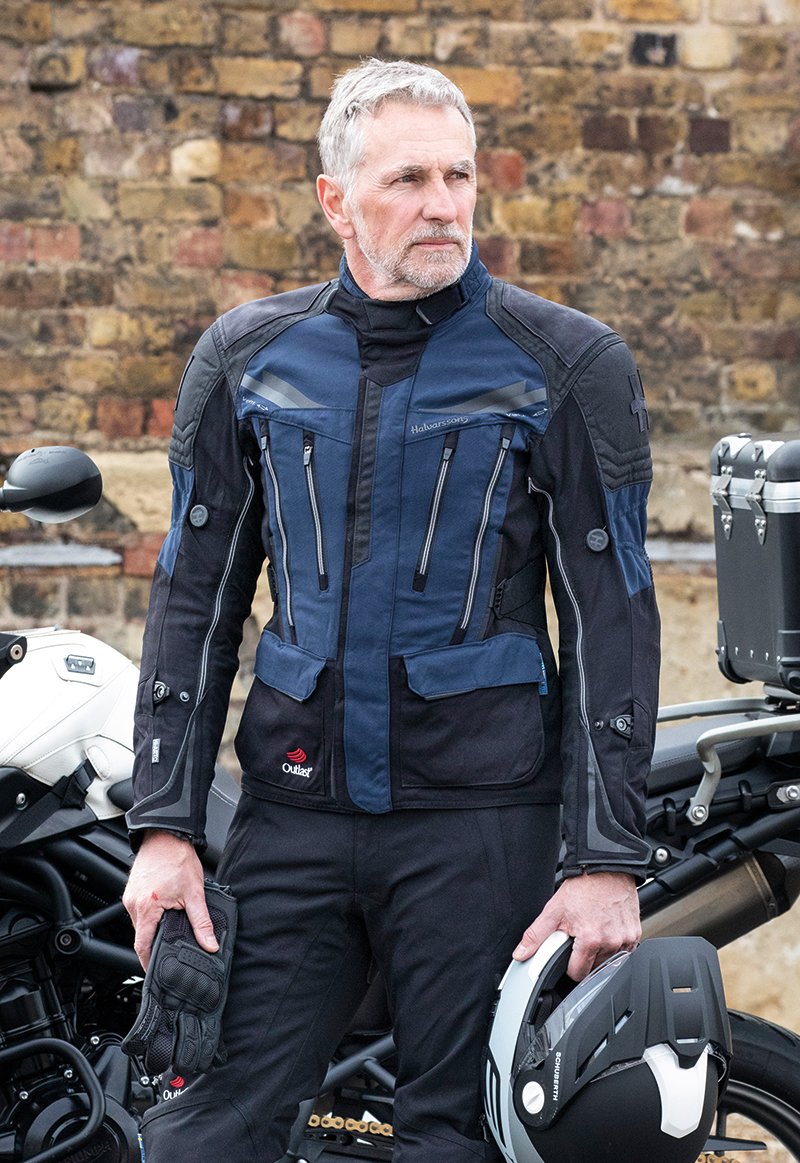
Despite what a lot of bikers, and even a lot of our customers, think, the role of a motorcycle jacket is not primarily to make you look dashing and handsome. A motorcycle jacket has two main functions. First to protect you in the event of an accident. Second to protect you from the elements. And in many ways the second is every bit as important as the first.

To start with, let’s talk about the accident side. Again, there are two ways in which a motorcycle jacket can provide physical protection. The first is the abrasion resistance of the jacket’s outer material. If we end up hitting the ground, and sliding down the road, we want to delay the point at which the rough tarmac starts to work its way through to our skin, muscles, tendons and bones.
The other way that a motorcycle can protect us in the event of an accident is to provide protection from impacts. The kind of impacts that happen when we go over the handlebars, for example, and land on an elbow, a shoulder, or on our back. Now the chassis of the jacket itself will have little to contribute when this happens. What protects us in the event of an impact, be it with the road, a car, a tree, a wall, or whatever, is the armour that is fitted into the jacket. You can wear the world's most abrasion-resistant leather jacket, but it will be of little added benefit if you hit something.
If you buy a motorcycle jacket in a motorcycle shop, it will ‘nearly always’ come with armour in the elbows and shoulders. (Confusingly, there are some exceptions to this rule). Some jackets will come with back protectors, but all jackets will offer the option to fit one if it doesn't come as standard.

Armour is a whole subject in its own right, and indeed we have done a video all about how armour works, but basically armour will be made from materials that will absorb and dissipate the force of an impact. Obviously, armour has its limits, but the idea is to prevent bones from breaking or fracturing.
But armour plays another vital role that is less talked about. It can add dramatically to the abrasion resistance of your outer garment, whether that be a jacket or a pant. If you are sliding down the road on your back, for example, a back protector will significantly delay that point we were talking about earlier; you know, the bit about, skin and muscles and tendons!

So armour is important, and these days armour is so much easier to wear than it used to be. Some modern armour is so thin and pliable, you barely know you're wearing it. Well, until things go wrong that is.
What you should know, however, is that there are two safety standards when it comes to armour. Level 1 and Level 2. Level 2 absorbs twice as much energy, but that will often come at the expense of greater bulk and diminished comfort. There is another factor at play here. Some protectors are no larger than a beermat; some of them are huge. The bigger stuff is going to provide you with more protection, but really it's all about choosing the appropriate level of protection for your riding. If you potter about in the hills on your Bonnie at the weekend, you really don't want the largest Level 2 armour you can find. Honestly, you don't!
The other protection that a motorcycle jacket provides is from the elements; that is the weather. And it's our view that this can be as important, in certain circumstances even more important, than protection from comings together.
These days, there is a lot of talk about 'passive safety'; this is about creating a comfortable environment for the rider so that all his or her energies and attention can go into riding well. In this way, you can better avoid having an accident in the first place.
With 'active safety', by contrast, you surround your body with ever thicker layers of protective materials, the result of which will be that, if you do have an accident, you will bounce better. With 'passive safety', the aim is to put the rider into a position that reduces those occasions where you need to bounce. What all of this means is that you need to be wearing a jacket that stops you getting too wet, too cold, or too hot.
If we get too hot, we get distracted, our attention is diverted. We lose the ability to make calm, measured decisions. If we stay too hot for too long, heat exhaustion can set in. We dehydrate. Our cognitive abilities will become further impaired. It's dangerous, especially as we usually don’t always know it’s happening.
Getting cold on the bike is another problem. If when you're riding down the road you are shivering, once again you won't be riding well. Get too cold and you become a danger to yourself and other road users. It is particularly important, of course, to protect your core. If your core is warm, your heart will be pumping warm blood around the body. Your toes, your legs, your arms, your fingers, and your head, will stay warmer too.

Getting wet is also something you want to avoid. Being wet if you're in a bath, or in a swimming pool, is fine. But it's not so nice if you're on a motorbike. Now water running down your back or into your undies is not pleasant, but actually the real issue with rain is the impact is has on body temperature. And that's because we lose body heat 20 times faster through a wet environment than we do through a dry one. So, if it's a cold day, and rain finds its way through your outer jacket to reach the body, you're on a timeline to being in trouble. Fine for a short while, but after a few hours, hypothermia can start to become a real concern.
Anyway, that's a brief run through. Your motorcycle jacket's primary function is to protect you, whatever the nature of the forces that you need to be kept safe from.
Let's now talk about the different types of motorcycle jacket. Note that I did not stay 'styles' of jacket; that would be a very different discussion. We are not concerned here about the design differences between an adventure jacket, an off-road jacket, an urban jacket, a retro jacket, a touring jacket, a commuting jacket, and so on. There may well be differences between such garments, but here we are going to concentrate primarily on the different ways in which motorcycle jackets can be configured and constructed.

Simplifying matters somewhat, there are basically two types of motorcycle jacket, in so far as the type of material for the outer chassis is concerned. There are leather jackets. And there are jackets made from textile or synthetic fabrics.
We will discuss both. The respective merits of the two materials are hotly debated. In truth, however, the facts are fairly straightforward. There's nothing to get particularly aerated about. But bikers can be a hot-headed and stubborn bunch. They can become somewhat entrenched in their beliefs. The longer somebody has been biking the deeper those convictions can run. And at times logic and reason have little bearing on the matter. Some people are simply not for turning.
And so, on that bombshell, let's talk first about leather jackets.

Now leather is an amazing material. Even though it hasn't altered much in over a millennium, it is still much beloved by bikers. And it cannot be denied that leather is naturally abrasion resistant. If you go down the road in a leather jacket, you would have to be going at a fair old lick to wear through it; although we have seen it, particularly where the leather is thin, or has not been treated, and has dried out.
Leather is also very comfortable. Buy a leather jacket a little on the tight side, and eventually it will mould to the shape of your body. It can, over time, literally come to feel like a second skin. But the truth is that, in a world where aircraft fly at supersonic speeds, where we send rockets to Mars, where we build bridges over a hundred miles long, and ships that displace more than half a million tons, leather is no longer the strongest material known to man. They stopped using leather for protective vests, after all, in the Middle Ages. Technology has afforded us materials that are stronger than the arse end of a cow. And increasingly these highly technical materials are being used in motorcycle wear.
Now those diehards who believe that leather is the only thing to wear on a motorcycle, often point to the fact that racers still wear leather suits. And so these folk contend that it must, therefore, be the best thing for motorcycle gear for riding on the road too. Well, the two disciplines are not comparable.

The one-piece racing suit was first worn in racing by Geoff Duke, he of the Isle of Man TT fame. But he did not wear it for extra protection, he wore it to minimise wind resistance. By wearing something that hugged the body he figured he could prevent the flapping that beset his waxed cotton jacket; and thereby reach higher speeds.
He was right. And indeed this is one of the reasons that racers still wear leather suits. Racers will wear their suits as tight as they possibly can. Even at 200 mph, there will be no flapping. The result is greater speed down the straight.
We have already acknowledged that leather is naturally abrasion resistant, but there is a particular reason why leather works so well on the race track. It is very smooth, in the way that woven fabrics never are. This smoothness enables riders to slide great distances down the track, without tumbling or rolling.
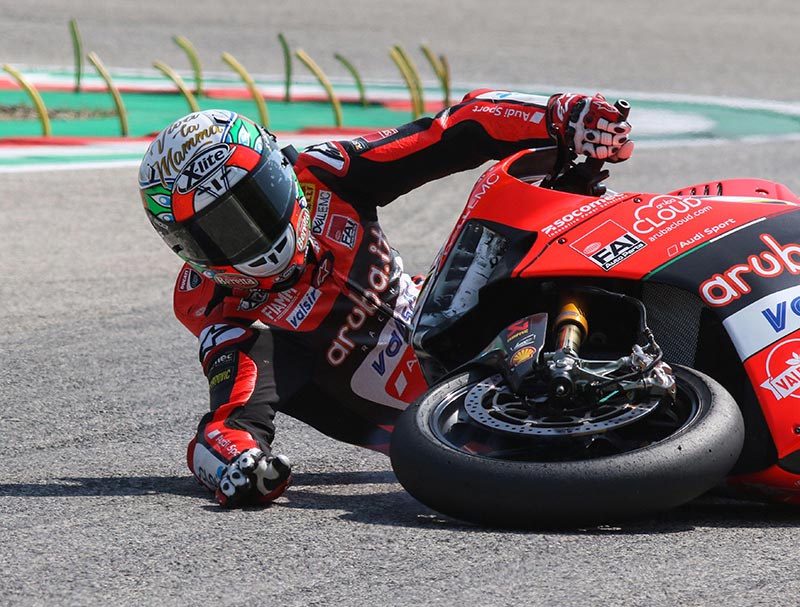
Does this mean that leather is the best material for the road? Well, for reasons we will come on to discuss, our response would be emphatically 'no'.
The fact is that the superior 'sliding’ qualities of leather are not so vital for road riding. Now, I am sure that there will be people who will claim that they have slid 200 yards down the central lane of the M1 but, in most cases, when we have an accident on the road, we tend not to slide too far. Our highways are not that smooth. We have potholes and manhole covers. We tend to slide a shortish distance. We will then roll over, sometimes multiple times. If we're lucky we will come to a stop. If we're not lucky, we will hit something.
In such circumstances, leather brings little to the party. We have acknowledged that leather slides more smoothly than textile fabrics, but rarely on the road are we going to benefit from this. And, of course, if we are eventually brought to an abrupt halt, then leather will provide no extra benefit over a suit made from synthetic materials, because that's the role played by armour.
But actually it's when we come to the other kind of protection, protection from the elements, that the weaknesses of leather really come to the fore.
On a relatively benign, dry day, where temperatures range from, say the mid teens up to the low twenties, leather will be fine. Indeed, on such a day, riding in leather is fabulous. I still have my 20 year old, Dainese two-piece suit, and there are times when I would not want to ride in anything else.
But once the weather becomes more extreme, leather starts to reveal its limitations. In hot weather, leather does not breathe particularly well. And so we will get hot and sweaty. And getting too hot on a bike, as we’ve discussed, is not a good thing. Which is why you wouldn't wear leather when riding off road, crossing a desert, or even on a tour through the southern half of Europe.

But, sorry, there's worse to come. It's when it rains that leather becomes totally inappropriate. Imagine a dry chamois cloth; the kind of cloth you dry the car off with. Well, that's what happens to a leather jacket when it rains. The leather will suck in the rain; the jacket will become heavy with moisture. This is uncomfortable, but the problem is that if the jacket becomes water logged, it won't take long before you start to feel uncomfortably cold as well.
Leather is also not great in cold weather, albeit for reasons that are not quite so easy to understand. Staying warm on the bike is all about layering. And, of course, you can layer beneath a leather jacket as easily as you can any jacket. But when you do, you will perspire; and when you do that your sweat has to escape into the ether. But because leather is not breathable, you will get wet from the inside. And if the temperature then drops further, you can find yourself in a very dangerous position because, as we’ve discussed body heat is lost far faster when the body is wet.

All of which leads us to a view. Everyone likes leather. Every biker wants a leather jacket. It is written somewhere that every biker has to own a leather jacket at some point in their time on two wheels. If you want to look like Brando, Presley, Douglas, Pacino, Pitt or Clooney, you're going to need a leather jacket.
But when it comes to serious ridin’, as opposed to serious posin’, leather starts to look less impressive. On a nice, dry, warm day a leather jacket is the business. In the hot, the cold and the wet, not so much!

In general, I suppose it would only be fair to point out that most leather jackets are going to be more abrasion resistant than most textile ones, although this is not invariably the case. This will be dictated by the thickness of the leather and the composition of the textile material in question. Nonetheless, as a generality, it is not inaccurate.
In Europe, there is a standard that measures the abrasion resistance of the outer chassis of motorcycle garments. It is known as EN17092. It is not a safety standard, per se; contrary to the surmise of some. It is purely a measure of the strength of a jacket or pant's outer shell. Garments are awarded an A, AA or AAA rating; A being the lowest; AAA being the highest.

And indeed this does seem to suggest that the leather vs textile debate is not a black and white matter. There are textile jackets that rate AAA under EN17092. And there are leather jackets that rate A. And vice-versa.
Most jackets sold in the shops these days are textile jackets of one description or another. Clearly, they come in all shapes, sizes and configurations. And so we're going to talk about the different constructions. Drop-liner. Laminated. Removable waterproof. Non Waterproof. Waxed Cotton.

A drop-liner jacket has a waterproof membrane that is fixed, and cannot be removed. Some people mistakenly believe that a ‘drop-liner’ jacket is one where the membrane can be ‘dropped’ out. That is not a drop-liner jacket. A drop-liner jacket is so-called because the membrane is sewn in and hangs, or ‘drops’, from the shoulders.
The membrane in a jacket performs two roles. It protects the wearer from getting wet. But, importantly, it also protects the rider from the pernicious effects of wind chill. Wind chill dictates how the body perceives temperature at speed. The faster you go, the colder you feel. A waterproof membrane will also be a very effective windproof membrane, so it will have a strong bearing on the how a rider feels in colder weather. Indeed as, in this country at least, it is cold more often than it is wet, it might even be suggested that a membrane will more often be called upon to keep a rider warm than it will be to keep him dry.
Before we go further, a few words about membranes and how they work. A membrane is like a very thin polythene sheet that contains many millions of tiny holes. Those holes are so small that rain droplets from the outside cannot pass through to the wearer; and so the rider stays dry from the outside. But those millions of holes are large enough to allow sweat particles from the skin to pass out into the atmosphere. And this is important, firstly because if this sweat could not escape the wearer would get wet from the inside. But it’s also important because sweating is the way the body cools itself down. And if the sweat cannot escape a rider could, in certain circumstances, start to overheat.

And so the membrane in a drop-liner jacket will serve to keep a rider both dry, both from within and without, and to some degree, warm. But there is, for some people, a weakness with drop-liner jackets. In heavy and prolonged rain, water can pass though the outer shell of the jacket. This rain will not find its way through to the rider, because it will be prevented from doing so by the membrane. But the rain swilling round between the outer fabric and the membrane can make the jacket feel heavy, and the rider feel cold. This is a state that is known as ‘wet out’. Now, this would only happen after many hours of riding in heavy rain, but it can happen. For most riders, however, it will be a very rare occurrence. Not many of us will often find ourselves riding for four hours or more in heavy rain. Which is why we personally still think that a drop-liner jacket is going to be the best option for 90% of riders.
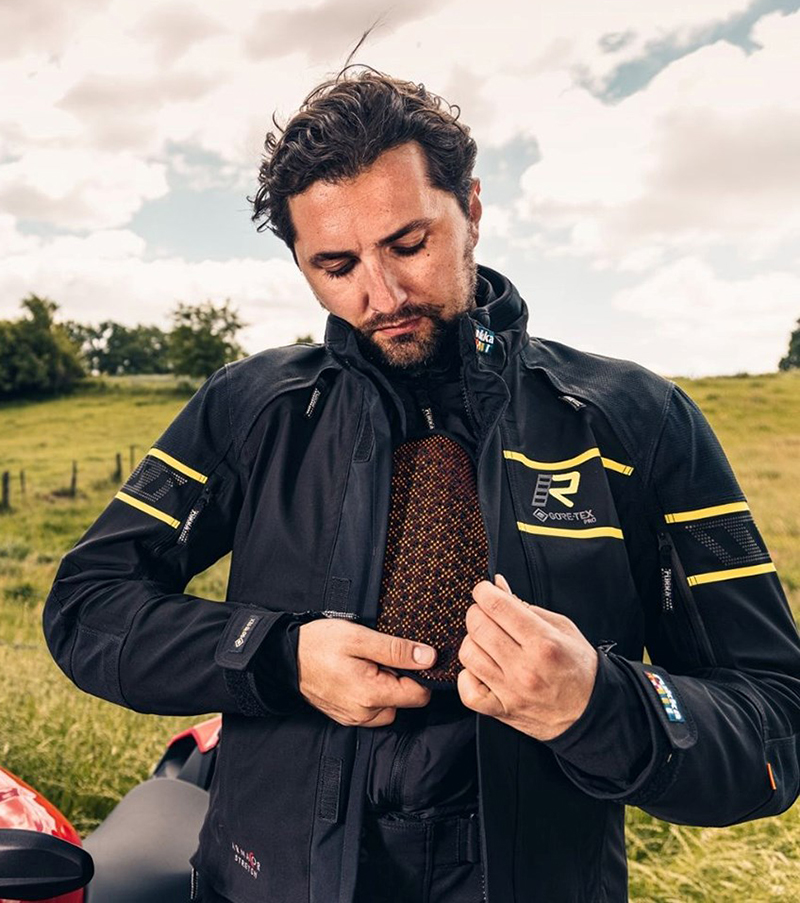
The jacket construction that overcomes this ‘wetting out’ problem is known as ‘laminated’. With a laminated jacket, the membrane is bonded, or heat sealed, to the inner side of the outer chassis of the jacket. With a laminated jacket the water cannot pass through the outer fabric at all, so the jacket will never reach that ‘wet out’ state. Now that sounds good; and it is true that in this respect a laminated jacket will outperform a drop-liner one. But you would only ever reap this benefit after many hours in the rain, as we have already explained.

There is, though, another benefit with a laminated jacket. Because it will not take on as much rain, it will dry out much more quickly at the end of a ride. Let’s say you commute for an hour or more into work in heavy rain in a drop-liner jacket. Your jacket won’t have wetted out by the time you get into work, but it could still be pretty wet, and so when it comes time to ride home in the evening you could find yourself putting on a damp jacket. And, on a cold, dark, winter’s evening that’s no fun. But because a laminated jacket takes on less of the wet stuff, it will dry out in an hour or so. So totally dry gear when the time comes to ride home.
As an aside, laminated jackets will also vent better as, when you open the zip, the air can pass directly through to the body. Open the vent zip on a drop-liner jacket, and the incoming air still has to combat the separate membrane.
But there are some quite significant downsides to laminated jackets. They are not as cosseting and comfortable as drop-liner jackets because, when you stick a membrane onto a fabric you make it less pliable, stiffer. There are other issues. A laminated jacket will not be as warm, as you will lose the insulating air gap between the outer chassis and the membrane.
Laminated jackets are also far more prone to failure, and leaking, than drop-liner ones. Drop-liner jackets are very simple to make. They do not require a high degree of skill to put together. A good, drop-liner jacket will not let you down. It will go on and on; if not forever, for a good long time.
Laminated jackets, which many bikers have convinced themselves they need, rely for their waterproofing on copious amounts of waterproof taping to prevent water ingressing wherever the panels that make up the jacket meet. Now, most motorcycle clothing manufacturers are driven by the need to hit a competitive price point. And so they skimp on the taping. They use inferior, cheap tape. And they don’t tend to use much of it.
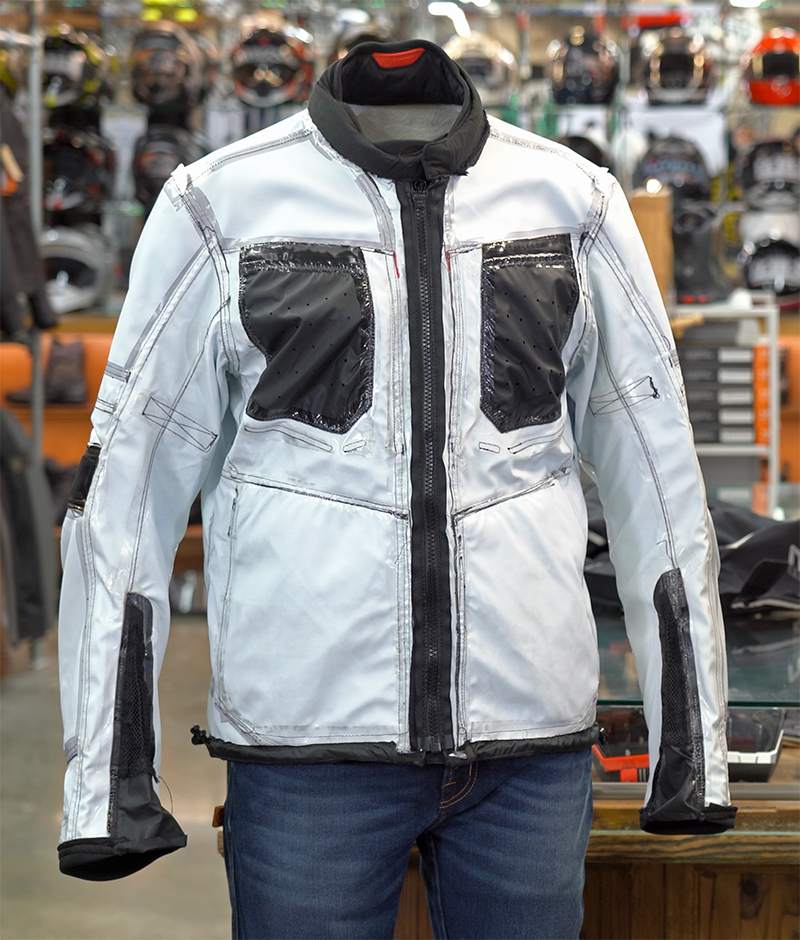
As a result, most laminated jackets end up not being particularly robust or reliable. If you don’t go out in the rain much, you’ll probably be fine. But if you do, there’s always a possibility that a cheap laminated jacket will let you down. Of course, what the manufacturers hope is that you’ll get through the warranty period; be that one, two or three years, before there’s a problem. Sometimes this happens, sometimes it doesn’t; but the truth of it is that less expensive, laminated jackets are not designed for the long haul. They are produced by manufacturers who want to be seen to be making laminated jackets! Keeping you dry is less important to them.
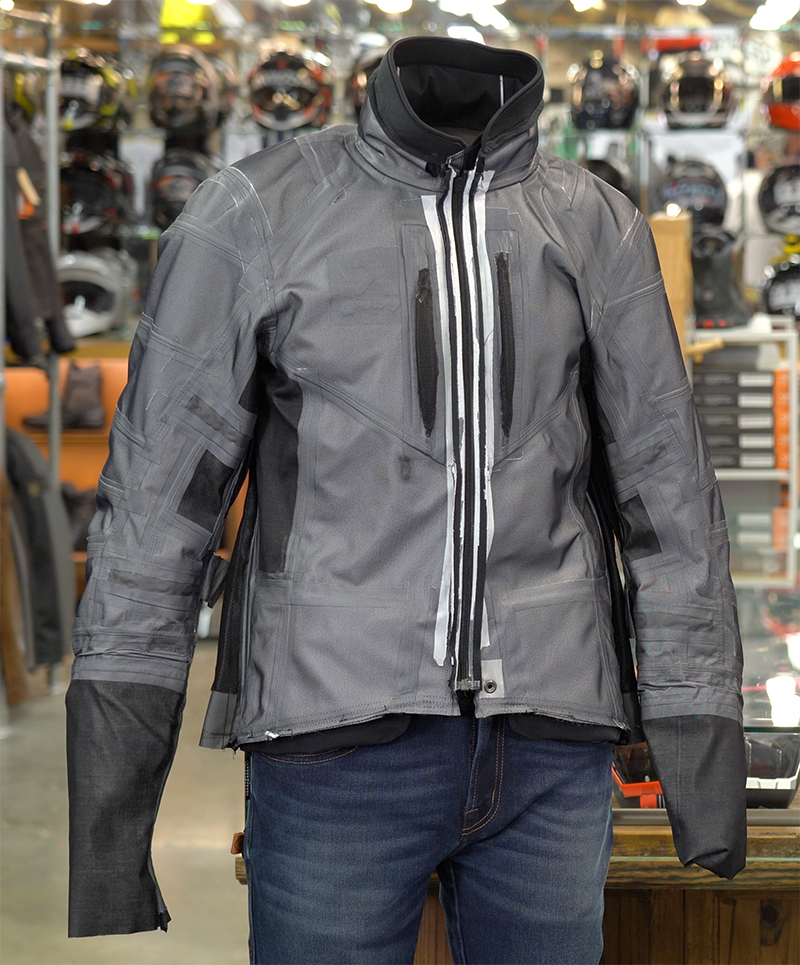
There is a very obvious exception to this generalised truth. And that is laminated jackets that are made with a Gore-Tex membrane. Gore makes the best membranes. They also know more about how to make laminated garments work. They pretty much invented the technology. And over the years they have perfected it. These days, Gore has a brand to protect, and so they will only allow a manufacturer to make use of its laminated membranes if they agree to a set of guidelines. A set of guidelines that make it almost impossible to make a poor-quality laminated jacket. You have to use Gore’s tape. And you have to use a lot of it.

Now, whilst we still feel that most people will be better off with a drop-liner jacket, we have no problem with laminated jackets if they work. And the inconvenient truth here is that the only ones that really do work, come with Gore-Tex membranes. But just in case you think we lack objectivity, what you need to know is that Gore’s jackets are guaranteed to stay waterproof, not for one year, two, years, three years, five years, or even six; but rather forever. And where this takes us is to is a position where we feel that if you need, as opposed to just want, a laminated jacket, you would be better off spending a little more, and going for something with a Gore-Tex laminated membrane. In the long term, it will pay dividends.

There is another type of waterproof motorcycle jacket; jackets that come with a membrane that can be removed. When the membrane is in place, attached with poppers, straps or zips, you have something that is similar to a drop-liner jacket. You will stay dry, but in a prolonged, heavy downpour such a jacket could eventually ‘wet out’. In truth, such jackets are not quite as waterproof as drop-liner ones because the rain can find its way over, or under, the waterproof inner.

But the real benefit of such jackets is that when you remove the membrane you have a jacket that will be highly breathable. The kind of jacket that will still be comfortable to ride in, in even the warmest of conditions. It’s why such jackets work so well for adventure riding. They tend to also be popular in southern Europe where anything with a membrane can become stiflingly hot. We have stated already that no jacket works in all conditions, but the fact is that a jacket with a removable membrane comes closer than most.

Some jackets without membranes are just that. Jackets without membranes. But there is another type of jacket without a membrane; it is known as a ‘mesh’ jacket. And basically these are jackets with large mesh panels that allow the air to flow even more freely. They are the ultimate expression in breathability, designed for one thing only. Hot weather.
In truth, you wouldn’t usually have a mesh jacket as your only jacket; unless that is you live somewhere a long way south of the UK. But a lot of motorcyclists will have a mesh jacket in the wardrobe so as to ride more comfortably on those days when the temperature is up, say, in the thirties.
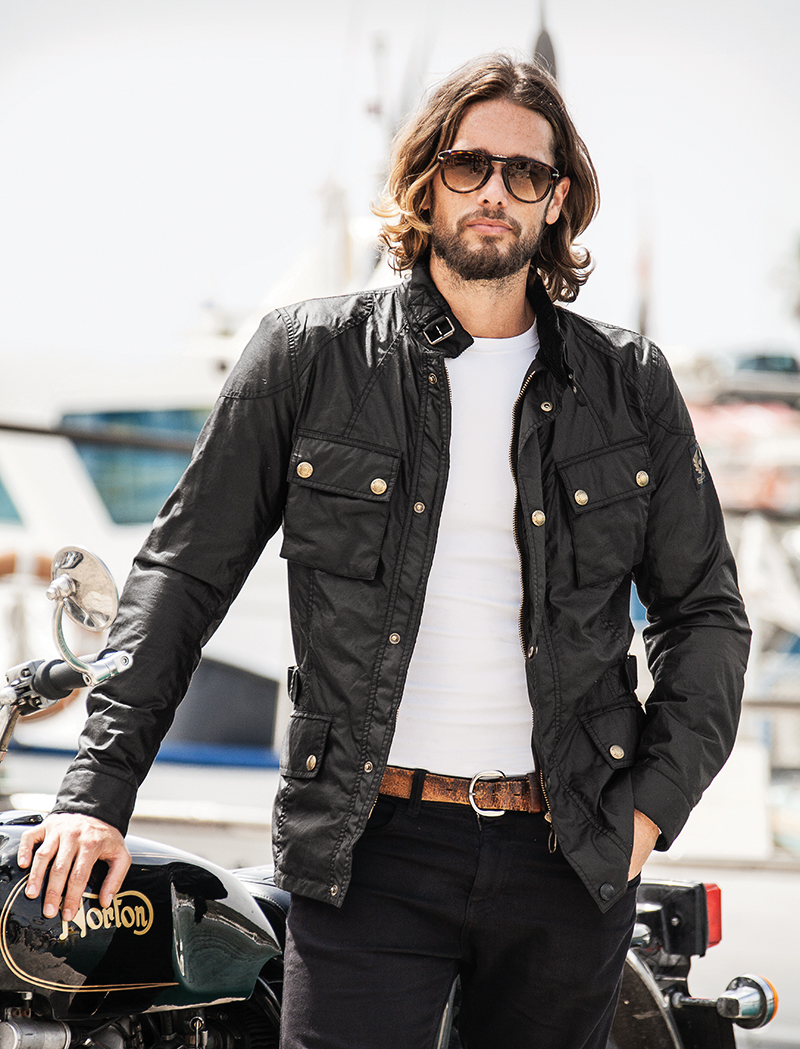
Some may feel that I have missed out on one particular construction; namely wax cotton. But normally wax cotton jackets are just wax-coated jackets with a drop-liner waterproof membrane. And so wax cotton jackets are more a style of jacket than a type of jacket. Although there is one thing that can be said about such jackets. And that is that, because the wax will prevent the rain passing through the outer fabric, a good wax cotton motorcycle jacket can provide near-laminate levels of protection from the wet stuff. Such a jacket will never ‘wet out’ provided, of course that the wax is re-applied every now and again.
One of the themes that has run through this review of jacket typologies is the need to be comfortable on the bike.
And so we have discussed the need to stay dry in the rain, and the need to stay cool in the heat. But we have not gone into great detail about how a jacket can impact upon our ability to stay warm, other than what we said about a membrane protecting us from the effects of wind chill.
The truth about staying warm on the bike, however, is that it is not usually the purview of the jacket itself. Now it is true that many jackets come with thermal liners although, in truth, most of these are tokenistic and not particularly effective. Many bikers simply take these out, put them in a bottom drawer, and forget about them.

Now getting cold on the bike is unpleasant. It can be debilitating, and can become dangerous; but staying warm on the bike is far easier than one might imagine. It is down to the layers you wear underneath the jacket. That could be a fleece, something in Merino, a down jacket perhaps, or if you really don’t like getting cold, something powered by the bike.
The truth is that staying warm inside a motorcycle jacket is not difficult. It is not a huge challenge. You just need to layer up appropriately. In extremis, that will be a heated jacket. And with a modern, heated jacket you can be just as warm on a winter’s day, after four hours in the saddle, as you were when you left home.
Many motorcyclists have made mistakes when buying a motorcycle jacket. Sometimes, we simply allow our head to rule our heart. But equally some of us, myself included, have often bought a jacket without really understanding what we were acquiring.
The more you ride, the more it will become clear that you are probably going to need more than one motorcycle jacket. But the trick, perhaps, is to work out what kind of riding you do most of the time, and to match that requirement with the kind of jacket that best meets your needs.

Of course, you’re still going to need to visit a motorcycle store, because you are going to want to make sure that the jacket you want is comfortable. You need to make sure that the shop you visit has a bike you can sit on, so that you can check whether the jacket is too long or too short, whether the elbow armour does protect the elbows, that the length of the sleeves is as it should be, that the jacket works both with and without your chosen layers, and so on.
And only if you’re happy at that stage, can you ask whether it comes in a colour to match your bike!
For more jacket information and to buy online, click motorcycle jackets.
Share this story
































































